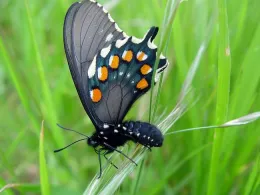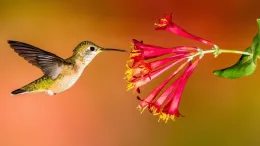
You've probably heard the alarming statistics on the decline of songbird populations. A study reported in Science magazine in 2019 gave the sobering news that nearly 3 billion birds (or 30% of the population) have been lost in the United States over the past 50 years.
A number of factors are behind this loss—cat predation, window crashes, diseases, climate change, and habitat loss. Cats kill approximately 2.4 billion birds in the U.S. each year. Keeping cats indoors or allowing them outside in a “catio” can reduce deaths from predation. Birds fly into windows because the reflection they see looks like a continuation of the outside environment. Patterns applied to glass, decals, and other specialized products are available to make windows appear more solid to birds. And it's important that bird feeders are cleaned regularly.
One of the important things gardeners can do is to create much-needed habitat for local and migrating birds. It's not difficult, and the resulting garden will benefit not only birds, but pollinators, insects, other wildlife, and people!
Following are ways to create a garden in which birds will thrive.
Choosing native plants is an important strategy. Natives support moths and butterflies which will increase the number of caterpillars available. This is critical because 96% of land birds rely on insects to feed their chicks—and caterpillars are full of the nutrients they need.
Usually, birds find the larvae when they are small, so the increase in caterpillars shouldn't decimate your landscape. It may require a shift in thinking about the purpose of your garden, remembering that we can't have butterflies—or food for birds--without caterpillars. I have seen social media posts of gardeners proudly displaying their California pipevine (Aristolochia californica) laden with larvae that will become pipevine swallowtail butterflies (Battus philenor hirsuta).

- Silver bush lupine(Lupinus albifrons), with blue to violet flowers from April to July.
- California fuchsia (Epilobium canum), which produces bright scarlet flowers in the summer until fall, when many other flowers have already faded.
- Woolly blue curls (Trichostema lanatum), whichproduce lavender blooms in fall, winter, and spring.
- Bush monkeyflower (Diplacus aurantiacus) which blooms winter, spring, and summer

- Large canopy trees, which provide roosting and nesting spots. Local examples include:
- Oaks (Quescus species) which provide acorns in the fall and habitat for numerous insects.
- White alder (Alnus rhombifolia), which produces catkins in the fall.
- Shrubs and small trees for fruits and seeds, such as:
- Coffeeberry (Frangula californica), with white flowers in the summer followed by dark red berries.
- Wedge-leaf buckbrush (Ceanothus cuneatus) which produces white, light blue, or lavender flowers in the winter and spring followed by seeds.
- Herbaceous plants for seeds. These are more bird-friendly if they are clustered in masses of 5 or more:
- Red-flowered buckwheat (Eriogonum grande var. rubescens), which is a native of the Channel Islands, but does well inland with a little afternoon shade and extra water. It blooms in the spring, summer, and fall and produces abundant seeds.
- California aster (Corethrogyne filaginifolia), which blooms later in the year—summer, fall, and winter—and also provides seeds.
- Decaying leaves and wood—to provide habitat for the insects birds rely on for food.
Providing water in a man-made birdbath or simply a hollow stone is also helpful to birds. Ideall, it will be near a tree or shrub for perching, with running water that attracts birds and discourages mosquitos. Birdbaths should be cleaned with a solution of 1 part vinegar to 9 parts water and refilled at least every other day.
Avoiding pesticides. Bird-friendly gardens are also habitat for insect predators such as frogs, toads, bats, dragonflies, praying mantises and lady beetles which will keep the bug population in check. If you determine pesticides are necessary, use low impact strategies described here.

Doug Tallamy, a professor in the Department of Entomology and Wildlife Ecology at the University of Delaware and the author of Bringing Nature Home says it well, “In the past, we have asked one thing of our gardens: that they be pretty. Now they have to support life, sequester carbon, feed pollinators and manage water.”
Make your garden more valuable by thinking of it from a bird's point of view. It can be a wonderful home for local species and a welcome rest stop for migrating birds.
For more information:
https://www.audubon.org/news/how-make-your-yard-bird-friendly-0
https://www.audubon.org/content/how-create-hummingbird-friendly-yard
https://www.growingagreenerworld.com/creating-a-bird-friendly-garden-margaret-roach/

